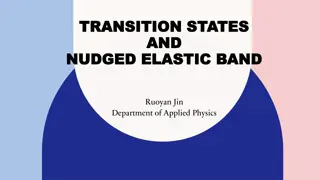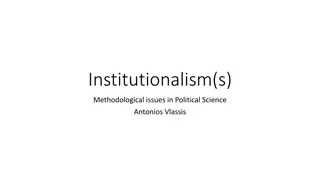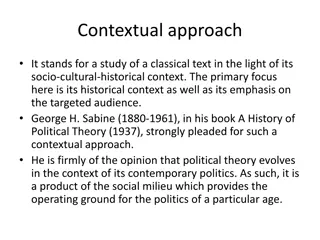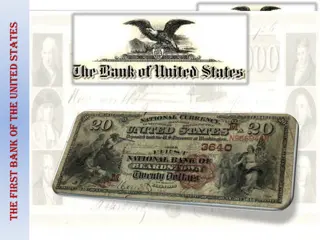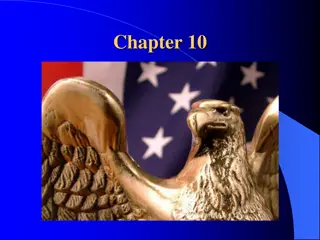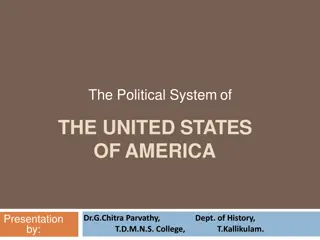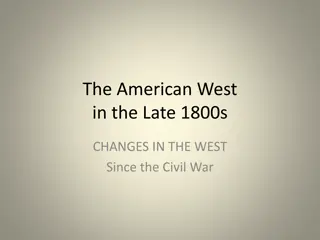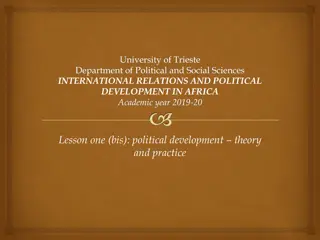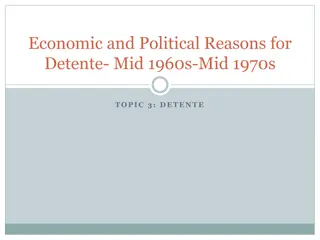Political and Economic Transition in Mid-1800s United States
Transition in mid-1800s United States sees North advancing politically and economically, while tension rises in the South over economic disparities. The North benefits from protective tariffs and controls key institutions, leading to a push for Manifest Destiny. Monroe's administration, with Adams' influence, pursues expansionism through treaties, aiming to expand US territory across the continent.
Uploaded on Sep 25, 2024 | 0 Views
Download Presentation

Please find below an Image/Link to download the presentation.
The content on the website is provided AS IS for your information and personal use only. It may not be sold, licensed, or shared on other websites without obtaining consent from the author. Download presentation by click this link. If you encounter any issues during the download, it is possible that the publisher has removed the file from their server.
E N D
Presentation Transcript
Review As we have discussed in previous classes, there is a lot of transition going on in the United States in this mid 1800 time period. You have the end of the War of 1812 and the policy of the United States in becoming more self reliant and self sustaining. You have the Northern part of the country progressing and establishing a strong political hold on the country. The people and the politicians are excited about the economy, the promise of new land with new wealth, no international conflicts or wars and only one political party running the country. Life is Good! In the South however, tension and animosity is building
Review In the South however, tension and animosity is building. The South rightly views the Northern states and politicians as financial opportunists. There is a strong political movement on behalf of the North to control the South. The North has established protective tariffs in an attempt to control the market value of cotton as a commodity. This benefits the economy of the North by keeping the raw product of cotton inexpensive so the North could make a larger profit on their clothing. It also make cotton expensive to sell to US competitors which in turn would drive up their final products compared to US made. The improved railroads, communication and roads are mostly benefiting the North. The US Bank is also under the control of the North.
Review At this point the United States under the political control of the North is in a very opportunistic situation. There is no internal conflict, the domestic economy is growing stronger everyday. The politicians are more confident and brash in their desires to destiny. The idea of bigger, stronger and wealthier becomes a main objective. Manifest Destiny and the philosophy of expansionism is also a large part of this Era of Good Feelings
Review With the Election of James Monroe in 1816, the Democratic Republicans take control. As you remember, the Federalist Party is destroyed and is lost to history. The Democratic Party believes they are invincible and Life is Good. Monroe appoints John Quincy Adams, the son of John Adams as his Secretary of State. And it is with Adams again where the United States begins to grow it s boarders JQ Adams is a strong expansionist and seeks to expand the boarders of the United States from Coast to Coast. Irregardless of who owns or lives in these lands. It is the Destiny of the US to expand from the Atlantic to the Pacific
Review It is Monroe's administration, through the directives of Adams that a series of treaties are enforced which allows this to happen. Treaties mostly between the US government and a few European countries which takes away lands from people and established countries who happened to be in their way. The following treaties are examples of Monroe s policy of expansionism through John Q Adams The Rush Bagot Treaty The Adams Onis Treaty of 1817 The Transcontinental of 1818 The Monroe Doctrine
Rush Bagot Treaty Convention of 1818 The Rush-Bagot Pact was an agreement between the United States and Great Britain to eliminate their fleets from the Great Lakes. The Convention of 1818 set the boundary between the Missouri Territory in the United States and British North America (later Canada) at the forty-ninth parallel. Both agreements reflected the easing of diplomatic tensions that had led to the War of 1812 and marked the beginning of Anglo-American cooperation. Although these agreements did not completely settle border disputes and trade arrangements, they did mark an important turning point in the American Canadian relations.
Adams Onis Treaty of the 1817 Also called the Transcontinental Treaty of 1819, the Adams-Onis Treaty was one of the critical events that defined the U.S.-Mexico border. The border between the Spanish lands and American territory was a source of heated international debate. Facing the fact that they must negotiate with the United States or possibly lose Florida without any compensation, Spain signed the treaty with the United States which drew a definite border between Spanish land and the Louisiana Territory. In the provisions, the United States ceded to Spain its claims to Texas west of the Sabine River. Spain retained possession not only of Texas, but also California and the vast region of New Mexico. At the time, these two territories included all of present-day California and New Mexico along with modern Nevada, Utah, Arizona and sections of Wyoming and Colorado.
The Monroe Doctrine Monroe Doctrine, is the cornerstone of U.S. foreign policy which was proclaimed by President James Monroe in his annual message to Congress in 1823. In declaring that the Old World of Europe and the New World of the United Sates had different systems and must remain distinct spheres, Monroe made four basic points: 1. The United States would not interfere in the internal affairs of or the wars between European powers. 2. The United States recognized and would not interfere with existing colonies and dependencies in the Western Hemisphere. 3. The Western Hemisphere was closed to future colonization. 4. Any attempt by a European power to oppress or control any nation in the Western Hemisphere would be viewed as a hostile act against the United States.
The Monroe Doctrine The Monroe doctrine was an outgrowth of concern in both England and the United States that the continental powers would attempt to restore Spain s former colonies, in Latin America, many of which had become newly independent nations. The United States was also concerned about Russia s territorial ambitions in the northwest coast of North America. As a consequence, George Canning, the British foreign minister, suggested a joint U.S.-British declaration forbidding future colonization in Latin America.










